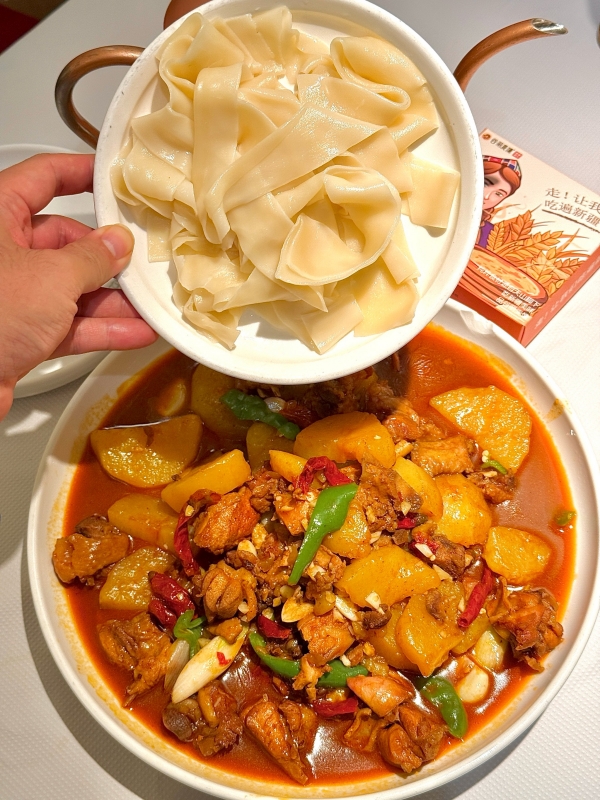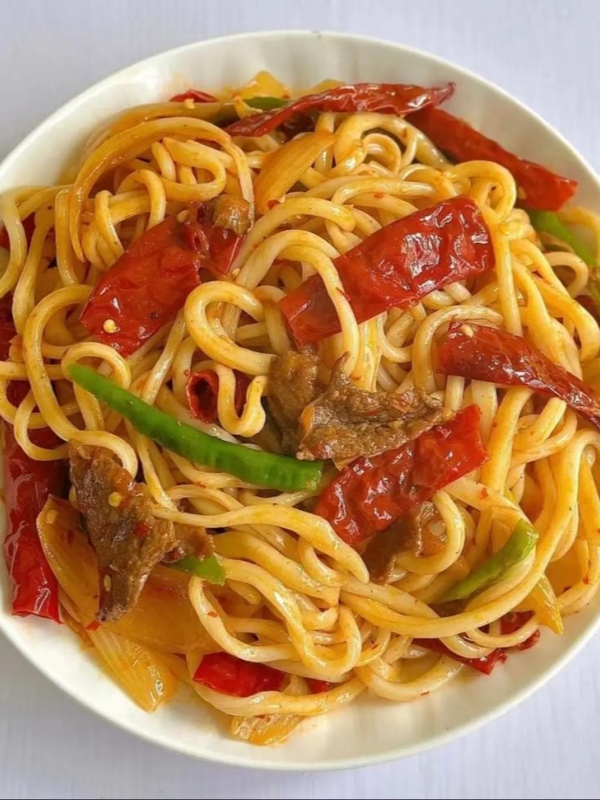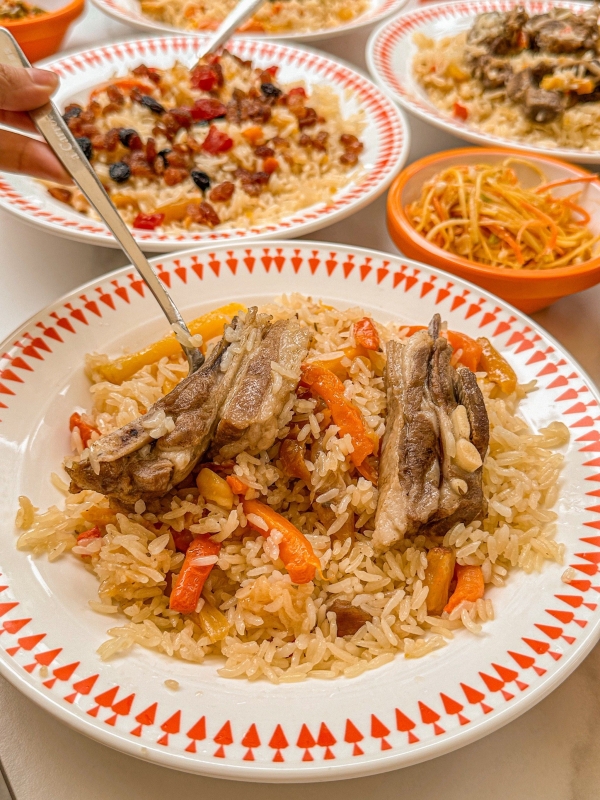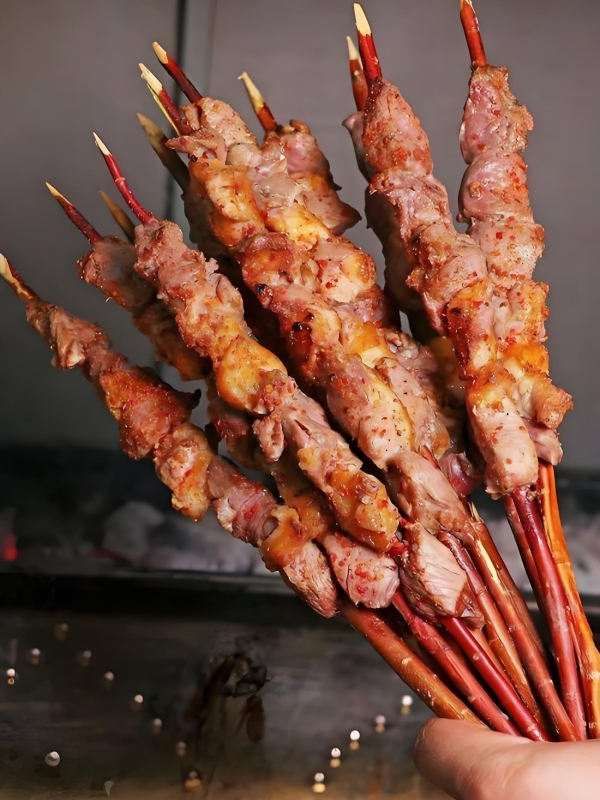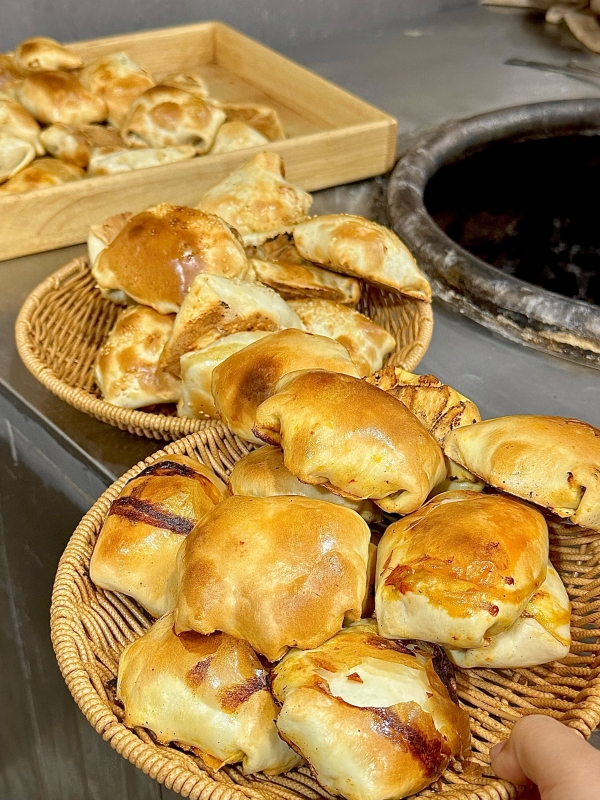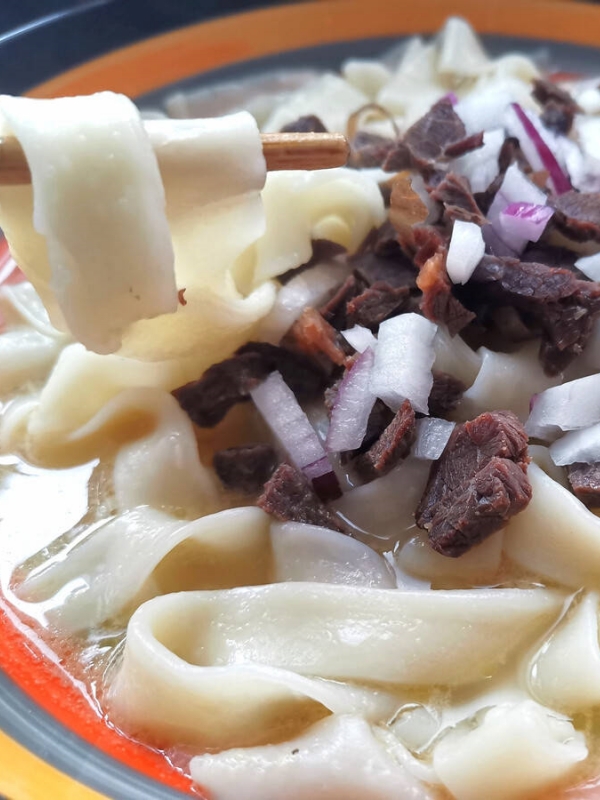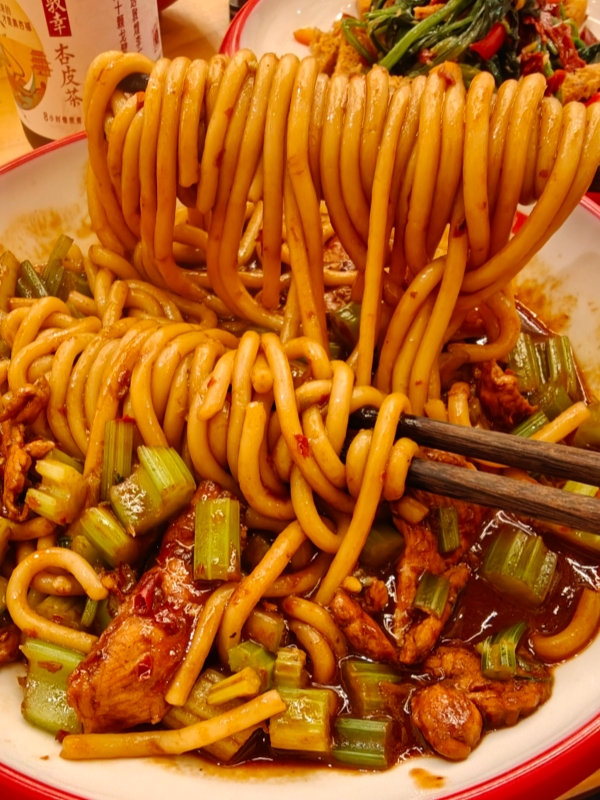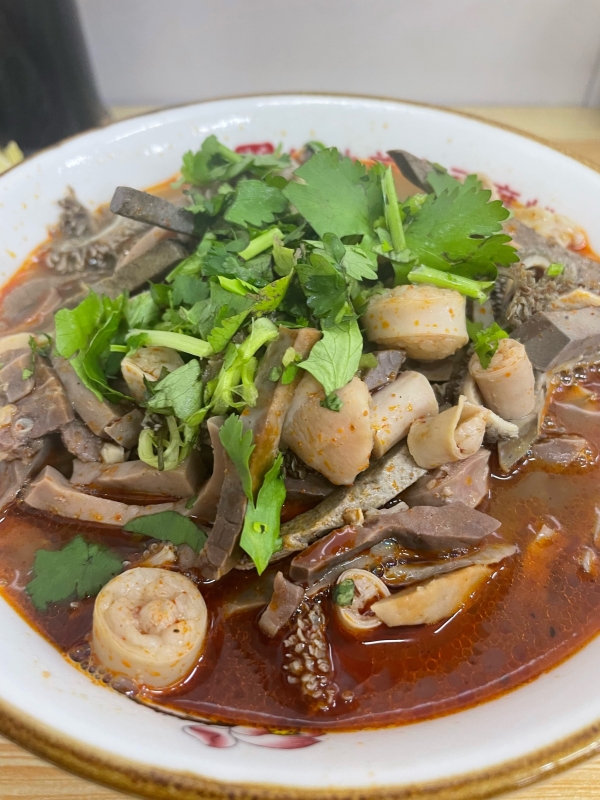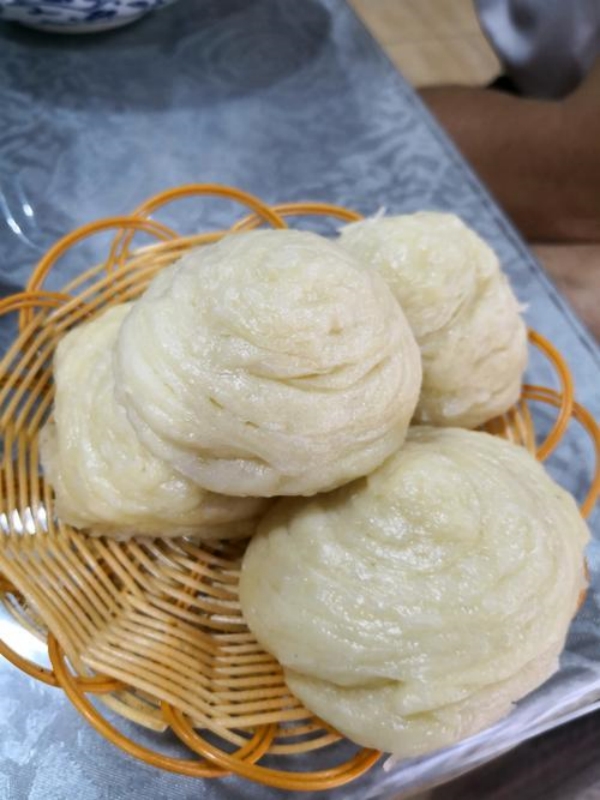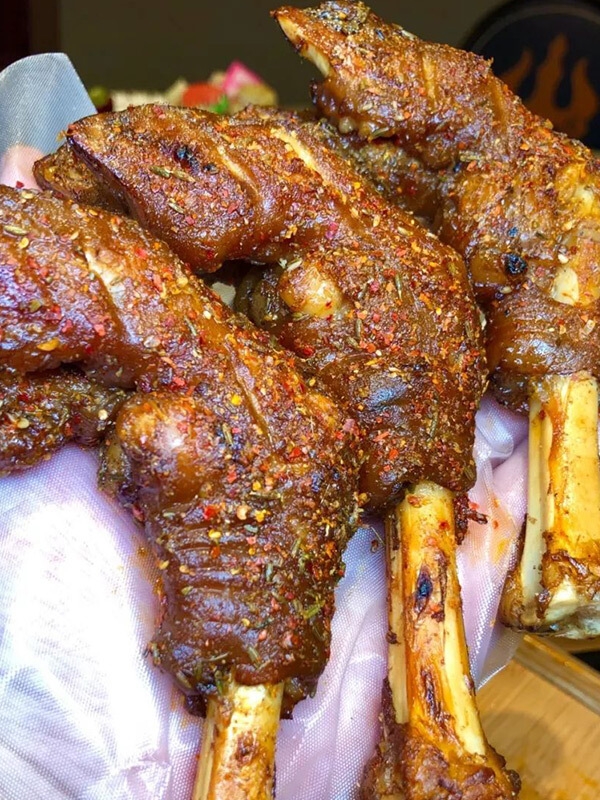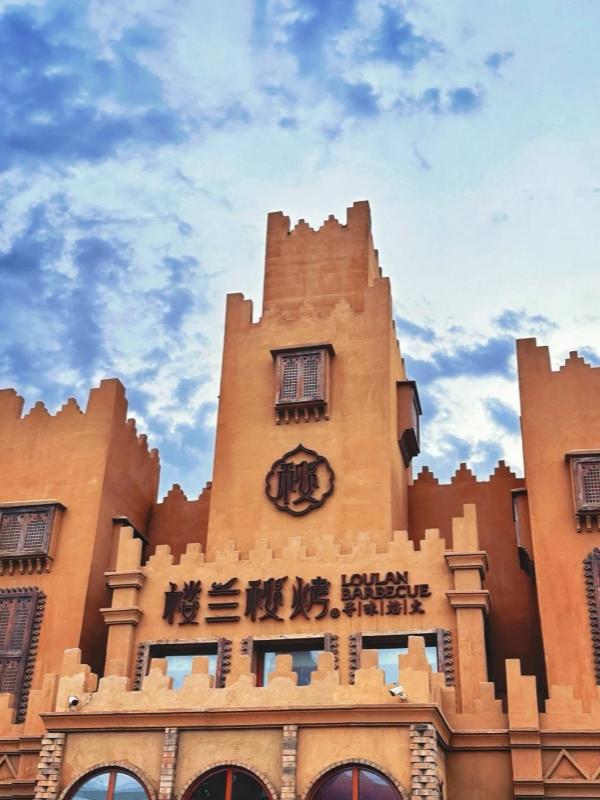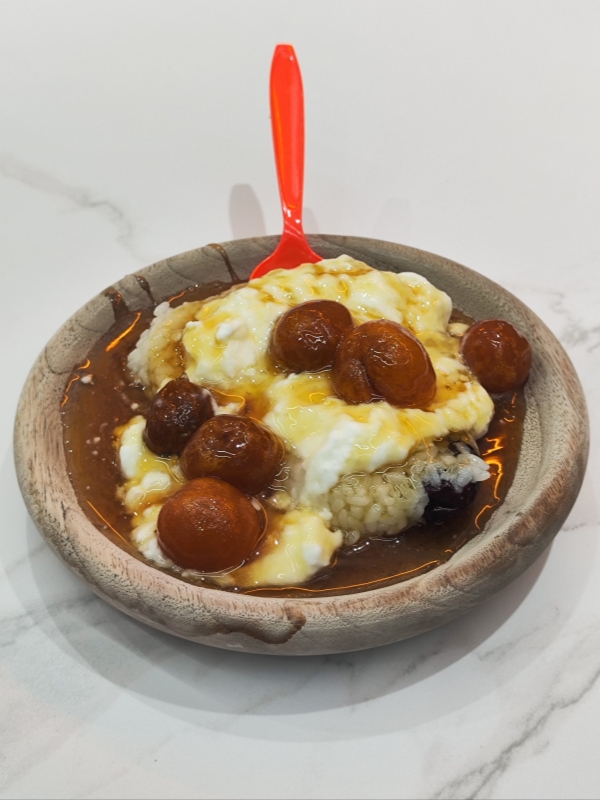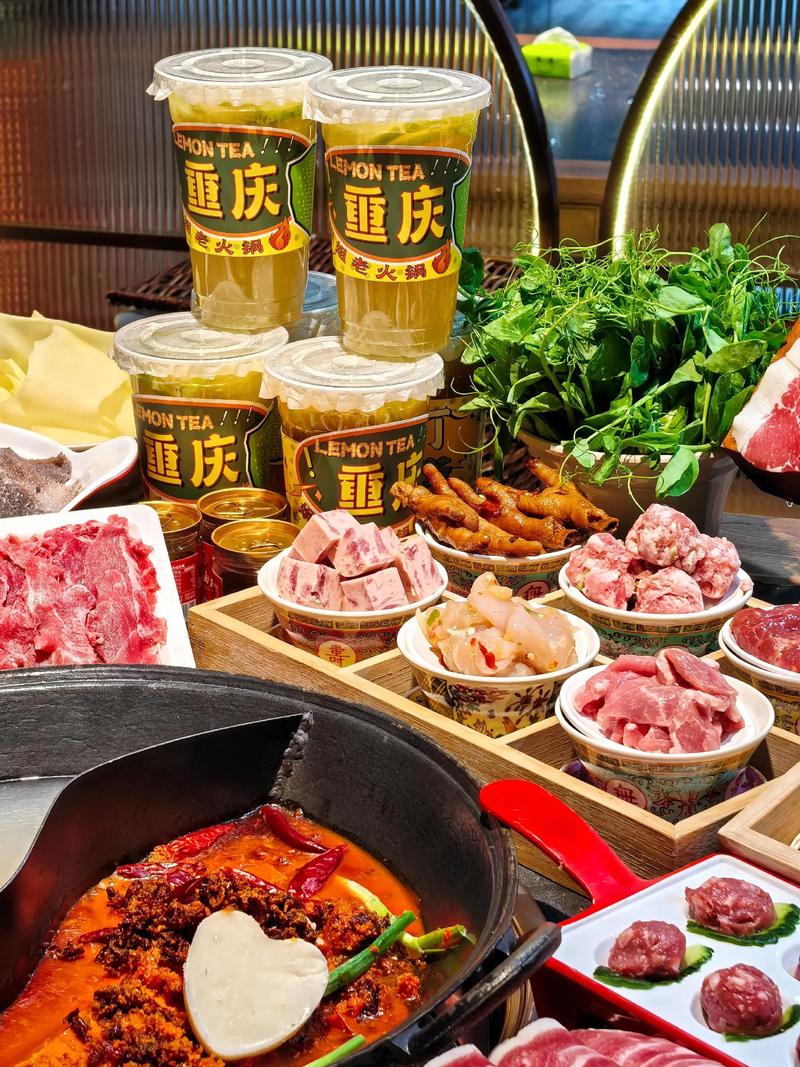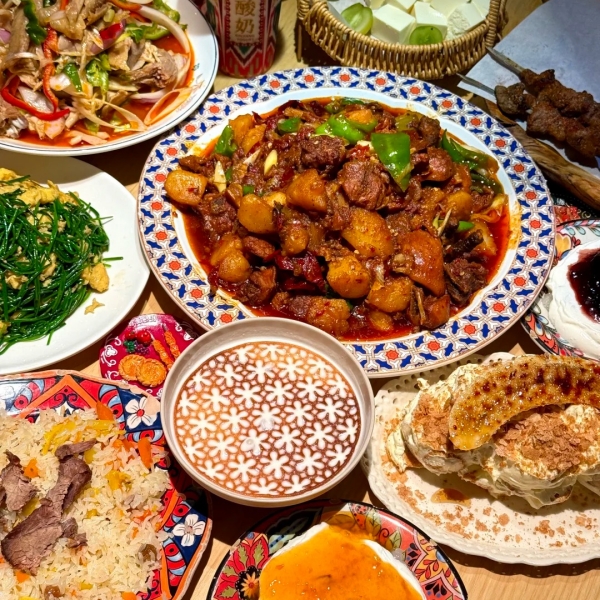
Xinjiang Food
Xinjiang food hits different as soon as you step off the plane. Rather than the typical flavors that travelers associate with China, in this remote region we see bold spices, heavy grilling and hearty basic ingredients influenced by their Central Asian neighbors on the Silk Road. In this guide, we’ll clarify what makes Xinjiang food unique compared to the rest of the country, which dishes are ubiquitous from Urumqi to Kashgar and how the local people bring everything to the table with their mixed cultural backgrounds.
In my many weeks traveling across the region, Xinjiang food taught me that truly good cuisine embodies the history of a culture, the community it comes from, and the identity that gives it meaning. From huge dishes served as a group to form and hand pulled noodles, each plate reveals something of life here. Ready to find out where the flavors come from and how to eat like a local? You’ve clicked into the right guide.
Xinjiang Food: Bold Flavors, Big Portions, Zero Compromise
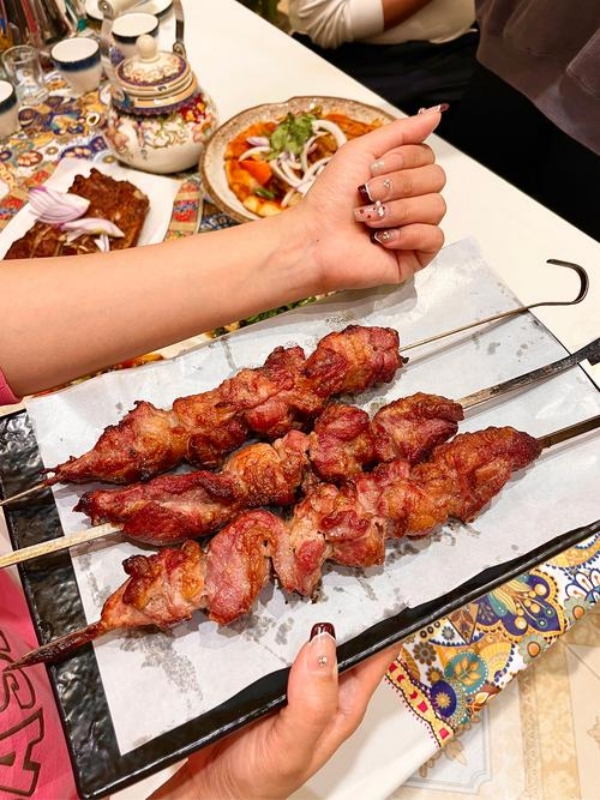
Kawaplar
Xinjiang sits at the crossroads of Central Asia and China, and its food reflects this unique position. While you might be familiar with Sichuan hotpot or Cantonese dim sum, Xinjiang cuisine operates by completely different rules. The region's Islamic heritage means pork is absent, replaced by lamb, beef, and chicken prepared in ways you won't find elsewhere in China, a reflection of the region’s deep Islamic culinary roots echoed nationwide through Halal Food in China 2025: Pure, Honest, and Delicious—The Muslim Culinary Heritage Across the Country.
The Silk Road isn't just ancient history here – it's on every plate. Cumin and black pepper replace soy sauce and Sichuan peppercorns. Thick hand-pulled noodles and pillowy naan bread take the place of rice. Meals are designed for sharing from large communal platters rather than individual bowls. And the flavors? They're bold, smoky, and unapologetically meaty.
Key Characteristics of Xinjiang Food:
| Category | Description |
|---|---|
| Basic Flavors | Bold and rich, with smoky and savory notes from grilling and roasting. Cumin and black pepper define the aroma and give dishes their iconic depth. |
| Specialty Ingredients | Lamb takes center stage, supported by beef and chicken. Ili Valley yellow carrots, naan flour, and fresh dairy showcase regional uniqueness. |
| Ethnic Influences | Strongly shaped by Uyghur and other ethnic traditions, including tandoor baking and communal-style dining practices. |
| Regional Features | Reflects Silk Road heritage with hearty portions, hand-pulled noodles, shared platters, and naan as a daily staple. |
| Taboo Reminder | Follows strict Halal customs—pork is never served. Diners should respect Halal practices when choosing dishes. |
Whether you're a seasoned foodie or a cautious eater, Xinjiang offers flavors you won't find anywhere else in China. This guide will walk you through the 12 essential dishes, where to find the best versions, and how to navigate this incredible culinary landscape like a local.
Signature Main Dishes - The Heart of Xinjiang Cuisine
1. Dapanji (大盘鸡) - Big Plate Chicken 🍗
Legend has it that a Sichuan immigrant to Shawan County brought dapanji (大盘鸡) to life in the mid-1990s; a mix of spicy heat with Xinjiang’s considerable portions, it swept the region up in a frenzy. Today, it’s the dish of Xinjiang, a bucket list, if you will. If you try one thing, it should be this.
What You’re Getting: An enormous iron platter the size of a pizza pan heaped with mouth-watering pieces of chicken simmering in a glossy red sauce splashed in soft potatoes, bell peppers, and onions. The chicken is braised to tenderization, and the splendid deep-fried potatoes soak up the numbing red sauce of Sichuan peppers and chilies. But the piece de resistance? The fist-thick, belt-like hand-pulled noodles (皮带面) tossed in the sauce.
💡 Pro Tip: The belt noodles are non-negotiable. Those wide, chewy strands are what make dapanji legendary. When ordering, always say "配皮带面" (pèi pídài miàn) – "with belt noodles."
2. Laghman (拉条子/拌面) - Hand-Pulled Noodles 🍜
Watching a master noodle maker is pure theater. Starting with a single dough ball, they stretch, fold, and slam it against the table in a rhythmic dance. Within minutes, that dough transforms into dozens of perfectly uniform noodles, each one bouncy and springy. I once spent twenty minutes mesmerized by this performance at a small restaurant in Urumqi – the skill level is extraordinary.
The Four Essential Varieties:
- 过油肉拌面 (Guòyóuròu Bànmiàn) - Fried Meat Noodles
- 野蘑菇拌面 (Yě Mógū Bànmiàn) - Wild Mushroom Noodles
- 番茄鸡蛋拌面 (Fānqié Jīdàn Bànmiàn) - Tomato Egg Noodles
- 麻辣拌面 (Málà Bànmiàn) - Spicy Noodles
The Eating Technique (This Matters!): When your noodles arrive, you have about 60 seconds before they start sticking together. Here's what locals do: immediately pick up your chopsticks, lift the noodles high, and let the sauce drip down, coating every strand. Mix vigorously. Don't wait, don't take photos first (okay, maybe one quick shot), just mix. If you wait too long, you'll end up with a clumpy mess instead of perfectly coated noodles.
3. Polo (抓饭) - Hand-Grabbed Rice Pilaf 🍚
Why Polo is Sacred: Among Uyghur families it’s a point of pride to be able to make perfect polo. The rice should be light, not gluggy. The lamb tender but not dry, and the carrots cooked long enough to sweeten but not so long they lose their shape. It’s skills learning, which is why great polo demands respect.
What Makes It Special: Instead of being fried in a wok like Chinese fried rice, polo is slowly steamed in a kazan, a kind of pot. The fat from the lamb drains into the rice, the onions turn brown and caramelise, the yellow carrots turn into sweet golden sticks. Put a handful of raisins or chickpeas in there and the polo-maker is an artist as well. The rice is rich but not oily, and savoury with sweet notes.
💰 Budget Win: Polo is usually the cheapest substantial meal you'll find. A hearty plate costs ¥15-30 and will keep you full for hours.
4. Kawaplar (烤羊肉串) - Lamb Kebabs 🔥
In Kashgar’s night market, I found my ideal kebab: 红柳烤肉 (hóngliǔ kǎoròu), in which fist-sized chunks of lamb are speared on a fresh red willow branch. As the meat cooks over charcoal, the branch gives off the subtlest fragrance of woodiness, imparting an unduplicatable aroma to the lamb. Believe me, metal skewers don’t come close: I tried when I got home!
The Anatomy of Perfect Kebabs: The best kawaplar start off with a good cut of lamb, ideally from the leg or shoulder, with a fat content of around 20%. Too lean, and the meat will dry out over the hot coals: too fatty, and it will drip and flare so dramatically that the outer layer burns while the inside is still rare. The meat is cubed, speared, then dusted with coarse salt, cumin, and chili powder, and is seasoned with those spices both before and after grilling.
| Kebab Style | Meat Chunk Size | Pieces per Skewer | Cook Time | Price per Stick | Perfect For |
| Standard Kebabs (普通羊肉串) | Small cubes ($approx 1$-inch) | 4-5 pieces | 5-8 minutes | ¥2-4 | Quick street snacking |
| Red Willow Kebabs (红柳烤肉) | Massive chunks (Fist-sized) | One or two pieces | 15-20 minutes | ¥10-18 | Sitting down for a proper meal |
5. Samsa (烤包子) - Baked Lamb Pies 🥟
The Filling Formula: Traditional samsa filling is deceptively simple: lamb (with some fat), onions, and sheep tail fat. That's it. The magic is in the ratio and the cut. The lamb needs to be diced small (about pea-sized) so it cooks through in the tandoor. The onion has to be abundant – usually a 1:1 ratio with meat – because it releases moisture that keeps everything juicy. And that sheep tail fat? It might sound intense, but it's what gives samsa their rich, savory flavor and ensures the filling stays moist, not dry.
The Crust Layers: A well-made samsa has a crust with distinct layers – almost like a laminated dough. When you bite into it, you should hear a slight crackle from the crispy bottom, feel the tender layers give way, and then hit that burst of hot, savory juice from the filling. It's a textural journey in every bite.
💡 Pro Tip: Pair your samsa with 茯茶 (fú chá) – a dark, fermented tea that cuts through the richness of the lamb. The combination is chef's kiss. Many samsa shops have a tea pot brewing in the corner – it's usually free or costs just ¥1-2 for a cup.
Noodle & Soup Dishes - Comfort in a Bowl
- Naren
- Stir-Fried Rice Noodles
- Yangza Tang
6. Naren (纳仁) - Cold Noodle Salad 🥗
What Is It: Thick, flat noodles (similar to fettuccine) are cooked, cooled, and tossed with thinly sliced lamb, raw onions, and a vinegar-based dressing heavy on black pepper. It sounds simple, but the balance is tricky. Too much vinegar and it's overwhelming. Not enough onion and it's bland. The perfect naren has a sharp tang that makes your eyes water slightly, followed by the savory lamb and the numbing heat of cracked black pepper.
🌡️ When to Order: Hot weather only. Ordering naren in winter would be like ordering iced coffee in a blizzard – technically possible but somewhat missing the point.
7. Stir-Fried Rice Noodles (炒米粉) 🍜
The Concept: Imagine chewy, elastic rice noodles stir-fried with a robust, spicy sauce, tossed with tender pieces of lamb or beef, and mixed with crunchy celery, colorful bell peppers, and fragrant garlic. That's stir-fried rice noodles. The noodles absorb every bit of the sauce's depth, the meat adds savory richness, and the vegetables provide a fresh, crisp contrast that balances the heat perfectly.
The genius is how the dish balances texture and flavor. Instead of the light, brothy quality of many noodle dishes, you get a concentrated, satisfying blend of spiciness, savoriness, and chewiness. It's perfect for lunch or dinner when you crave something flavorful, filling, and packed with Xinjiang's signature bold tastes.
Best Season: Year-round. While it's especially comforting on cool days, its addictive flavor makes it a favorite no matter the weather.
8. Yangza Tang (羊杂汤) - Lamb Offal Soup 🥘
What's In It: "杂" (zá) means "mixed" or "miscellaneous," which is a polite way of saying "various organs." You're looking at lamb liver, lung, intestine, heart, stomach – basically everything except the mainstream cuts. These are cleaned meticulously, sliced thin, and simmered in a milky-white broth with ginger, garlic, and white pepper.
Why It's Actually Delicious: The broth is where the magic happens. After hours of simmering, it becomes rich and creamy (from the collagen and fat), with a subtle gamey flavor that's balanced by white pepper's clean heat. The various organs offer different textures – liver is tender, lung is spongy, intestine has chew. It's a textural adventure.
⚠️ Real Talk: If the idea of organ meat makes you queasy, skip it. No judgment. But if you're open to trying it, go to a busy local spot in the morning when the soup is fresh. The quality makes all the difference between "interesting" and "never again."
Street Food Essentials - Eat While You Walk
9. Nang (馕) - Tandoor Bread 🫓
The Basics: Nang is baked in a tandoor oven (same as samsa) and comes in countless varieties. The most basic version is about the size of a dinner plate, slightly crispy on the outside, soft and chewy on the inside, with a characteristic dimpled pattern from being pressed before baking. More elaborate versions have toppings like sesame seeds, nigella seeds, or are stuffed with meat or vegetables.
The Varieties You'll See:
- Oil Nang (油馕): Brushed with oil before baking, making it richer and more savory. This is the one locals buy for traveling because the oil helps it stay fresh longer.
- Sesame Nang (芝麻馕): Covered in sesame seeds. Nutty flavor, more interesting texture. Slightly more expensive (¥3-4 vs ¥2 for plain).
- Meat Nang (肉馕): Stuffed with ground lamb and onions. This is basically a meal in itself. Perfect for long bus rides.
10. Suannai (酸奶) - Thick Yogurt 🥛
How It's Served: Most places serve it in small bowls with honey or sugar on the side. You add sweetness to taste. Some vendors offer fruit toppings, but purists argue that good yogurt needs nothing added.
Why It's Essential: Beyond being delicious, yogurt is your best friend in Xinjiang. Had too much spicy dapanji? Yogurt. Feeling heavy after all that lamb? Yogurt. Hot afternoon and you need cooling down? You guessed it – yogurt. Locals eat it with every meal, and after a few days, you will too.
💡 Pro Tip: Every morning, buy a container of yogurt from a street vendor (usually ¥3-5) to keep in your hotel mini-fridge. It's the perfect breakfast, snack, or late-night treat.
11. Xinjiang Youtazi (新疆油塔子) - Layered Steamed Pastry 🥠
These are the iconic layered steamed pastries of Xinjiang, beloved for their delicate texture and aromatic flavor. Thin sheets of dough are brushed with oil and spices, then rolled and twisted into tower-like shapes before steaming. They’re flaky and tender, with layers that peel apart easily, and infused with a subtle savory aroma from sesame oil or cumin.
When You'll Find Them: Youtazi are a staple at breakfast tables and family meals across Xinjiang. They’re often served alongside savory dishes like lamb soup, hand-grabbed rice, or stir-fried vegetables. Locals pair them with hot tea to balance the richness, making them a versatile addition to any meal.
💰 Budget Delicacy: Usually ¥8-15 for a plate of 4-6 pieces. Perfect for sharing with family or friends, or enjoying as a satisfying standalone snack.
12. Kaogeda (烤羊蹄) - Grilled Lamb Trotters 🦶
The Appeal: Lamb trotters are all about texture. There's barely any meat – what you're after is the gelatinous skin and tendons. After being grilled over charcoal and hit with cumin and chili, they develop a slightly chewy, deeply savory quality that's oddly addictive. It's not elegant eating (you're gnawing on bones), but it's fun and delicious.
The Technique: You hold the trotter by the bone and bite/pull at the skin and tendons. Think of it like eating chicken wings – it's hands-on, messy, and best enjoyed with friends and cold beer. Most vendors provide plastic gloves, but some locals just go bare-handed and deal with the sticky fingers later.
💡 Pairing Suggestion: Kaogeda + cold Wusu beer (Xinjiang's local brew) = perfect night market combination.
Where to Eat Like a Local - Top 6 Best Xinjiang Restaurants
- Loulan Secret Roast
- Yogurt Zongzi
- Sichuan Pepper Chicken
Finding authentic Xinjiang food shouldn't be a guessing game. After personally visiting 50+ restaurants across Urumqi, Yining, and Kashgar (and gaining 8 pounds in the process), I've put together this verified list. Every single restaurant below can be found on Meituan (美团) or Dianping (大众点评) – China's trusted review platforms.
💡 Pro Tip: Download these apps before your trip. Even without Chinese language skills, star ratings (4.5+ is solid gold) and food photos will guide you. Look for 必吃榜 (Must-Eat List) badges – these are legit.
1. Loulan Secret Roast (楼兰秘烤) ⭐️ 4.8+
This place captures that ancient Silk Road atmosphere everyone dreams about. The Loulan-themed decor isn't just for show – you're dining in what feels like a desert oasis. The place is packed every night, and for good reason. The atmosphere transports you back to the days of caravans and spice traders, while the food keeps you firmly planted in the moment.
Can't-Miss Dishes:
- 🥩 Roasted Lamb Ribs (烤羊排) - Fall-off-the-bone tender, perfectly charred
- 🍮 Yogurt Zongzi (酸奶粽子) - Unique dessert, sweet-tangy combo that's oddly addictive
Address | Yingbin Road Branch, Urumqi (Chain stores available on Meituan/Dianping) |
Business Hours | 11:00 - 24:00 |
Price Range | ¥80 - ¥120 per person |
Suitable For | Tourists, family gatherings, friends get-togethers |
2. Haierbagh Dining (海尔巴格餐饮美都) ⭐️ 4.7+
Multi-year resident of Meituan's "Must-Eat List," this restaurant is where local Uyghur families celebrate birthdays and special occasions. The moment you walk in, the intricate traditional decorations tell you this isn't some knock-off tourist trap. The authenticity runs deep here – from the hand-carved wooden details to the way servers explain each dish with genuine pride.
Star Performers:
- 🌶️ Sichuan Pepper Chicken (椒麻鸡) - Numbing spice that makes your lips tingle in the best way
- 🍚Hand-Grabbed Polo (手抓饭) - Their version has a cult following
Address | Southwest of No.1 Nuerbeixi Road, Kashgar (Near Id Kah Mosque) |
Business Hours | 10:00 - 23:00 |
Price Range | ¥60 - ¥90 per person |
Suitable For | Local families, tourists, special occasions |
3. Ayilkasir Restaurant (艾勒喀斯尔餐厅) ⭐️ 4.5+
"Palace-style Uyghur dining" might sound pretentious, but this place delivers. Ranked in Meituan's Top 3 for Ili cuisine, the interior looks like you're dining in a traditional Uyghur royal court. The attention to detail in both presentation and preparation shows why this restaurant has earned its stellar reputation among both locals and visitors who know their food.
Must-Try:
- 🥟 Baked Samsa (烤包子) - Fresh from the tandoor, crispy exterior with juicy lamb filling
- 🍚 Polo (手抓饭) - Made with that special Ili Valley yellow carrot that's sweeter than anywhere else
Address | Yining City, Ili Kazakh Autonomous Prefecture (Check specific location on Meituan) |
Business Hours | 11:00 - 22:30 |
Price Range | ¥70 - ¥110 per person |
Suitable For | Food lovers, tourists, family dinners |
4. Little Gazi Xinjiang Food (小尕子新疆菜) ⭐️ 4.3+
This chain took traditional Xinjiang recipes and made them slightly more accessible without losing authenticity. Their innovation actually works – they've figured out how to present centuries-old dishes in a way that respects tradition while accommodating modern dining preferences. The portions are reasonable, the flavors are authentic, and the atmosphere strikes a perfect balance between casual and refined.
Star Dishes:
- 🍲 Nine Bowls Three Rows (九碗三行子) - Traditional feast-style presentation, perfect for groups
- 🥛 Gazi Yogurt (尕子酸奶) - House-made, ridiculously thick and creamy
Address | 5th Floor, Tianbai Fashion Shopping Mall, Aksu (Chain stores available on Meituan) |
Business Hours | 10:30 - 22:00 |
Price Range | ¥70 - ¥100 per person |
Suitable For | Groups, friends, family, casual diners |
5. Aizati Polo House(艾力扎提抓饭馆) ⭐️ 4.3+
Locals' breakfast spot of choice. If you're not there by 9 AM, the yellow carrot polo sells out. I'm not exaggerating – I saw a "sold out" sign at 9:47 AM on a Tuesday. This is the real deal: no-frills, no-nonsense, just incredible polo made the way it's been made for generations. The owner sources his yellow carrots from a specific farm in the valley, and you can taste the difference.
The Essential Combo:
- 🍚 Yellow Carrot Polo + 🥟 Thin-skin buns = Perfect breakfast
Address | No.17 Tawuguzi Road, Kashgar |
Business Hours | 7:00 - 14:00 (Breakfast-focused, sold out once stock is gone) |
Price Range | ¥30 - ¥50 per person |
Suitable For | Locals, breakfast lovers, budget diners |
6. Golden Goblet(黄金樽) ⭐️ 4.0+
Luxurious Uyghur banquet hall and Meituan's top pick for high-end dining in Kashgar. This is where important business deals get sealed over elaborate feasts and where families gather for milestone celebrations. The staff treats every meal like an event, and the traditional music performances on weekend evenings add to the grandeur. Yes, it's expensive, but the experience and quality justify every yuan.
The Showstopper:
- 🐑 Whole Roasted Lamb (烤全羊) - Must reserve 1-2 days ahead, serves 8-10 people, costs ¥1,500-2,200
Address | No.1 Tawuguzi Road, Kashgar |
Business Hours | 12:00 - 23:00 (Traditional music performances on weekends) |
Price Range | ¥80 - ¥150 per person (Whole roasted lamb priced separately) |
Suitable For | Business dinners, milestone celebrations, groups |
Essential Dining Tips & Practical Advice
Useful Restaurant Phrases
That's a very helpful set of phrases! Pointing definitely works, but knowing these phrases can make your restaurant experience much smoother.
Here is the information presented in an English table format:
| Category | Mandarin Phrase (Pīnyīn) | Meaning (English) |
| Arriving | 有位子吗? (Yǒu wèizi ma?) | Got space? / Do you have a table? |
| Ordering | 推荐什么? (Tuījiàn shénme?) | What do you recommend? |
| Ordering | 不要辣 (Búyào là) | No spice, please. |
| Ordering | 微辣 (Wēi là) | Little spice / Mildly spicy. |
| Paying | 买单 (Mǎidān) | Check please. |
Handling the Spice
Xinjiang food isn't as universally spicy as Sichuan cuisine, but certain dishes (looking at you, dapanji) can be intense.
Start Mild: Begin with 微辣 (wēi là, mild) even if you believe you can handle more heat. It's safer to add spice than to try and remove it.
Yogurt is Your Friend: Keep yogurt or other dairy products nearby. They are more effective than water at cooling your mouth.
Naan to Neutralize: Naan bread (or similar starchy, dry bread) also helps to absorb and neutralize the spice.
Avoid Cold Water: If something is too spicy, do not drink cold water. Water spreads the capsaicin (the compound that causes heat).
Stick to Dairy/Fatty Foods: For relief, stick exclusively with dairy products (milk, yogurt) or fatty foods, as the fats help dissolve the capsaicin.
💡 Lost in Translation: Sometimes "mild" in China is still pretty spicy by Western standards. Start conservative.
Taking Food To-Go
Plastic Bag Culture: In Xinjiang, takeout comes in plastic bags. Not containers – actual bags. Your noodles will be in a bag, tied with a knot. Your soup will be in a bag. Everything is bags. It's weird at first, then you realize it's actually practical.
Open Carefully: Seriously, soup in a bag can explode! Make sure to open it slowly and over a safe surface.
Transfer to a Bowl: Pour the contents into a bowl if one is available. This makes it much easier to eat.
Use Chopsticks: Use your chopsticks to fish out the solid ingredients (like noodles, meat, and vegetables).
Do Not Drink Directly from the Bag: This is a rookie mistake! Use the bowl to drink the soup, or use a straw/spoon if needed.
Frequently Asked Questions about Xinjiang Food
Q: Is Xinjiang food halal?
Most local dishes follow halal rules because many communities here are Muslim, so you’ll spot “清真” signs everywhere. Pork rarely appears on menus, and kitchens usually keep things clean and simple, which makes it easy for travelers who follow halal diets. Street spots and family-run places stick to tradition, while bigger restaurants maintain clear labeling. If you ever feel unsure, just ask the staff and they’ll guide you. Overall, finding halal options in Xinjiang is effortless and stress‑free.
Q: How spicy is Xinjiang food really?
Spice levels vary a lot, and the heat never hits you the way Sichuan food does. Dapanji brings some fire, but plenty of dishes stay mild and fragrant, letting the natural flavors shine. Chili is the main source of heat, with the occasional numbing kick from peppercorns. If you want to keep things gentle, just say 不辣 or 微辣 and they’ll adjust it. Most kitchens are chill about customizing spice, so you can eat comfortably either way.
Q: Can I drink the tap water?
Tap water isn’t safe to drink, so stick to bottled water or boiled hot water from hotels. Convenience stores sell bottles for pocket change, and tea is always a reliable option since it’s brewed with boiling water. Sealed drinks are fine, and you’ll find them everywhere. Ice in fancy places is usually okay, but it’s better to pass in smaller spots. When in doubt, keep things simple and grab a bottle to stay hydrated without worries.
Q: What if I have xinjiang food allergies?
Allergy awareness can be hit-or-miss, and kitchens may mix ingredients, so clear communication matters. Learn phrases like “我对__过敏” and “严重过敏” to explain your situation, but don’t rely solely on talking. Bring a printed card listing your allergens in Chinese and show it to staff before ordering. Peanuts, sesame, eggs, and nuts appear often, especially in snacks. Being prepared helps you stay safe while still enjoying local flavors without stressing over hidden ingredients or cross‑contact.
Q: How much should I budget for xinjiang food per day?
Daily costs shift with your style. Budget travelers can eat well on simple breakfasts, casual lunches, and street snacks. Mid‑range spenders enjoy nicer meals with more variety and comfort. If you like slower dinners, hotel breakfasts, or stylish cafés, expect a higher total. Xinjiang meals are generous, so even inexpensive dishes feel satisfying. Plan based on how often you eat out, how adventurous you feel, and whether you want to try signature dishes that usually cost a bit more.
Q: Is tipping expected when eating xinjiang food?
Tipping isn’t part of the culture, so restaurants won’t expect it, and giving extra cash may even confuse staff. Most places include service in their prices, and nicer hotels sometimes add a small service fee directly to the bill. Beyond that, you can just pay the listed amount and leave. Locals rarely tip in everyday settings, so you won’t stand out by following that norm. It keeps things simple and lets you focus on enjoying your meal comfortably.
Q: Can I drink alcohol with Xinjiang food?
Beer is common in many restaurants, and Wusu Beer is the go‑to choice thanks to its strong, crisp taste. You’ll see it at night markets, hotel spots, and Han‑run eateries. In more traditional Uyghur settings, alcohol might not be served, so it’s smart to check the vibe first. A quick scan of the tables tells you everything: if locals are drinking, you’re good; if not, keep it respectful. Pairing beer with kebabs is a local favorite for a reason.
Q: What's the deal with horse meat?
Horse meat matters in Kazakh cuisine and shows up mostly in places like Yining. It’s often smoked or made into sausage, giving it a lean, slightly gamey taste that some travelers love. Trying it is totally your call; many visitors find it interesting, others skip it. If it’s offered in a cultural setting, it’s polite to consider tasting a little, but saying you’re not comfortable is fine. People usually understand and won’t push you. Follow your comfort level.
